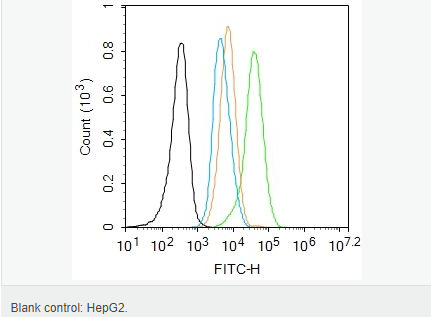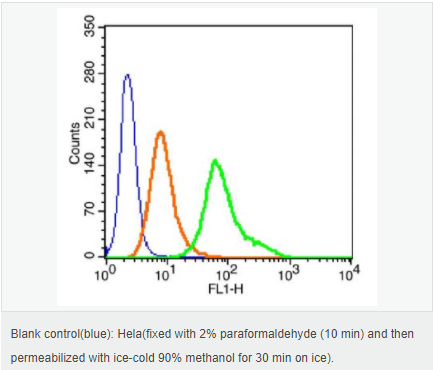

貨號
產(chǎn)品規(guī)格
售價
備注
BN40339R-100ul
100ul
¥2470.00
交叉反應(yīng):Human(predicted:Mouse,Rat,Horse,Rabbit) 推薦應(yīng)用:Flow-Cyt,ELISA
產(chǎn)品描述
| 英文名稱 | phospho-SNAIL + SLUG (Ser246) |
| 中文名稱 | 磷酸化鋅指轉(zhuǎn)錄因子Slug+SNAIL抗體 |
| 別 名 | SNAIL + SLUG (phospho S246); p-SNAIL + SLUG (phospho S246); SNAIL + SLUG (phospho S246 + S251); SNAIL + SLUG (phospho Ser246 + Ser251); phospho-SNAIL(Ser246) + SLUG(Ser251); phospho-SNAIL(Ser246) + SLUG(Ser251); dJ710H13.1; MGC10182; Neural crest transcription factor Slug; Protein sna; Protein snail homolog 1; Protein snail homolog 2; Protein snail homolog; Slug homolog zinc finger protein; Slug zinc finger protein; SLUGH; SLUGH 1; SLUGH1; SLUGH2; SNA; Sna protein; SNAH; SNAI 2; snai1; SNAI1_HUMAN; Snai2; SNAI2_HUMAN; Snail 2; Snail homolog 1 (Drosophila); Snail homolog 2; Snail2; WS 2D; WS2D; Zinc finger protein SLUG; Zinc finger protein SNAI1; Zinc finger protein SNAI2. |
| 產(chǎn)品類型 | 磷酸化抗體 |
| 研究領(lǐng)域 | 腫瘤 細(xì)胞生物 免疫學(xué) 發(fā)育生物學(xué) 神經(jīng)生物學(xué) 信號轉(zhuǎn)導(dǎo) 干細(xì)胞 細(xì)胞凋亡 鋅指蛋白 表觀遺傳學(xué) |
| 抗體來源 | Rabbit |
| 克隆類型 | Polyclonal |
| 交叉反應(yīng) | Human, (predicted: Mouse, Rat, Horse, Rabbit, ) |
| 產(chǎn)品應(yīng)用 | ELISA=1:5000-10000 Flow-Cyt=1μg/Test not yet tested in other applications. optimal dilutions/concentrations should be determined by the end user. |
| 分 子 量 | 29kDa |
| 細(xì)胞定位 | 細(xì)胞核 |
| 性 狀 | Liquid |
| 濃 度 | 1mg/ml |
| 免 疫 原 | KLH conjugated synthesised phosphopeptide derived from human SNAIL around the phosphorylation site of Ser246:TF(p-S)RM |
| 亞 型 | IgG |
| 純化方法 | affinity purified by Protein A |
| 儲 存 液 | 0.01M TBS(pH7.4) with 1% BSA, 0.03% Proclin300 and 50% Glycerol. |
| 保存條件 | Shipped at 4℃. Store at -20 °C for one year. Avoid repeated freeze/thaw cycles. |
| PubMed | PubMed |
| 產(chǎn)品介紹 | This gene encodes a member of the Snail family of C2H2-type zinc finger transcription factors. The encoded protein acts as a transcriptional repressor that binds to E-box motifs and is also likely to repress E-cadherin. SLUG is involved in epithelial-mesenchymal transitions (EMT) involving E-cadherin repression which is known to play an important role in tumor progression amd neural tube formation. SLUG also has antiapoptotic activity. Mutations in this gene may be associated with sporadic cases of neural tube defects (referenced from Entrez gene). Function: SNAIL is involved in the epithelial to mesenchymal transition (EMT) and formation and maintenance of embryonic mesoderm (By similarity). Binds to 3 E-boxes of the E-cadherin gene promoter and represses its transcription. SLUG is a transcriptional repressor, involved in the generation and migration of neural crest cells. PTM: SNAIL is phosphorylated by GSK3B. Once phosphorylated, it becomes a target for BTRC ubiquitination. Ubiquitinated on Lys-98, Lys-137 and Lys-146 by FBXL14 and BTRC leading to degradation. BTRC-triggered ubiquitination requires previous GSK3B-mediated SNAI1 phosphorylation. Similarity: Both SNAIL and SLUG belong to the snail C2H2-type zinc-finger protein family. Tissue specificity: SNAIL is expressed in a variety of tissues with the highest expression in kidney. Expressed in mesenchymal and epithelial cell lines. SLUG is expressed in placenta and adult heart, pancreas, liver, kidney and skeletal muscle. Subunit: Interacts with FBXL14 and GSK3B. Interacts with BTRC; interaction occurs when it is phosphorylated on the destruction motif. Interacts (via SNAG domain) with WTIP (via LIM domains) (By similarity). Interacts (via SNAG domain) with LIMD1 (via LIM domains), and AJUBA (via LIM domains). Interacts with LOXL2 and LOXL3. Subcellular Location: Nucleus. Cytoplasm. Note=Once phosphorylated (probably on Ser-107, Ser-111, Ser-115 and Ser-119) it is exported from the nucleus to the cytoplasm where subsequent phosphorylation of the destruction motif and ubiquitination involving BTRC occurs. Tissue Specificity: Expressed in a variety of tissues with the highest expression in kidney. Expressed in mesenchymal and epithelial cell lines. Post-translational modifications: Phosphorylated by GSK3B. Once phosphorylated, it becomes a target for BTRC ubiquitination. Ubiquitinated on Lys-98, Lys-137 and Lys-146 by FBXL14 and BTRC leading to degradation. BTRC-triggered ubiquitination requires previous GSK3B-mediated SNAI1 phosphorylation. O-GlcNAcylation at Ser-112 is enhanced in hyperglycaemic conditions, it opposes phosphorylation by GSK3B, and stabilizes the protein. Similarity: Belongs to the snail C2H2-type zinc-finger protein family. Contains 4 C2H2-type zinc fingers. SWISS: O95863 Gene ID: 6615 Database links: Entrez Gene: 6591 Human Entrez Gene: 6615 Human Entrez Gene: 20583 Mouse Entrez Gene: 20613 Mouse Omim: 604238 Human SwissProt: O43623 Human SwissProt: O95863 Human SwissProt: P97469 Mouse SwissProt: Q02085 Mouse Unigene: 360174 Human Unigene: 48029 Human Unigene: 2093 Mouse Unigene: 4272 Mouse Important Note: This product as supplied is intended for research use only, not for use in human, therapeutic or diagnostic applications. |

